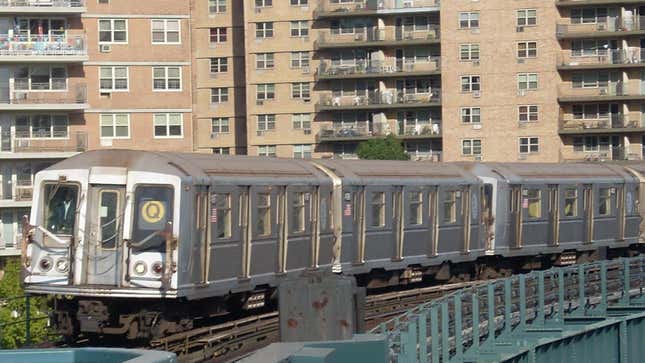
52 years ago this month, a new set of futuristic subway cars called the R40s entered regular service on the F between Coney Island and Jamaica. The cars were designed by famed industrial designer Raymond Loewy and they were meant to symbolize the atmosphere of change the subway and the city were undergoing at the time.
You see, the subway was in the midst of unification. The IRT, IND, and BMT lines were becoming integrated into one system that would span most of the city. Just a few months before the R40 was introduced, the Christie Street Connection project reconfigured tracks around the Manhattan Bridge, joining the BMT and IND into a unified set of lines for the city’s wider lettered trains, the exact lines the new cars would run on.
And to celebrate the spirit of progress, Loewy designed a car that intentionally did away with the classic boxy silhouette that had been the hallmark of subways cars prior. Instead of traditional upright car ends, Loewy’s R40s had fiberglass ends that slanted away from one another. It was a revolutionary design choice, though perhaps not unexpected to those familiar with the designer’s portfolio. His car designs, in particular, have always been polarizing in the way they bucked convention for flash, while his steam locomotives and his livery for Air Force One have always been considered some of the finest examples of Modernist design.
While the appearance of the R40s seemed to convey the zeitgeist surrounding the big administrative and infrastructural changes the city’s transit system was undergoing, the design had problems that would foreshadow the decrepit next stage in the legacy of the subway.
Though the cars looked cool, the slanted ends were dangerous for people passing between cars. Back then, it was much more common for passengers to move between cars, and conductors were required to make the step from one car to another to operate the doors when the train came into a station where the platform was on the opposite side from the forward-facing cab.
The fix was simple. The transit authority retrofitted sets of pantographs and higher grab bars to the front of each car to keep those passing between the cars safer from an accidental fall or pinch between the cars. Though the solution did largely work, there was a problem. The cars’ rakish futuristic design was ruined by the new additions and the cars would look progressively worse as graffiti and deferred maintenance took their toll on the entire system in the decades to follow their introduction. The new cars would be undone by their forward-thinking design, looking even worse than the rest of the system.
Luckily for the newly consolidated Metropolitan Transit Authority, the R40s contract hadn’t been completed by the time they realized the new design was going to be a problem. To mitigate the damage, the MTA had St. Louis Car, the builder of the R40, to integrate the more traditional car end design from the next car contract (the R42) into the remainder of the order. The new cars were called R40Ms or Modified, and the design used for their ends would be the model for basically all of the city’s cars built through the 1980s.

Though there would be problems with new cars introduced in the 1970s and ‘80s like the R46s and the later R68s, there was a lot going on back then to distract from those specific issues with the subway. The problems with the R40s would remain the hallmark example of an order for subway cars gone wrong. At least until now.
These days, the R40s are gone, all retired more than ten years ago, but the MTA is facing down another batch of problematic new cars: The R179s. These cars, built by Bombardier (which has been faced with a number of unhappy customers recently), were supposed to be the fourth set of new cars purchased since a new set of design standards (called New Technology Train, or NTT) were introduced with the R142 cars back in 1999, also built by Bombardier. Despite that pedigree, the cars have been so bad that one official has deemed them “lemons.”

The main problem facing the R179s isn’t at the ends, though, it’s down the sides. The door mechanisms have been reportedly allowing the doors to open while the cars are in motion. Other issues are also plaguing the cars, with train operators concerned about the impact of poor cab ergonomics on their ability to do their jobs safely and comfortably. All of this has caused the MTA to pull all of the R179 cars currently in service and replace them with whatever older cars they can find to fill the gap.
That’s a tall order for the MTA right now. In case you don’t know anyone who has spent more than five minutes in the New York Metropolitan Area in the last three or so years, the subway is not in great shape once again. Service is slow, delays are regular. It’s beginning to look a lot like the decline the system took back in the ‘70s with whole trains covered in graffiti, even.
Ironically, more than fifty years after they first saved the day the first time with their conservative design, the humble R42 has done it again. Though officially retired, the R42 cars that remain usable have been pressed back into service to make up for the unusable R179s languishing in the yards while a fix to the door problems is put in place. Maybe there is something to be said for keeping it simple, after all, eh?